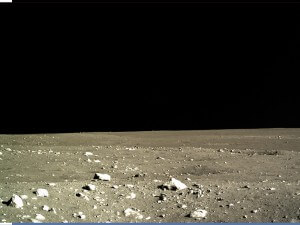
Jutu: What on the moon crippled the Chinese rover?
 13. 01. 2023
13. 01. 2023

On the surface of the Moon, the Chinese router Jutu still lives and works, or the Nephrite Rabbit (although he has not moved away for almost half a year). The Chinese media has come up with news on the cause of vehicle damage these days.
Rover Jutu went to the surface of the Moon 14. December 2013, just a few hours after his Chang'e 3 probe collided in the area called Rainbow Bay, on the northern edge of the Sea of Rain. China, thanks to this mission, gained a slightly higher post among the cosmic powers, because after 37 years, the controlled landing of a spacecraft on the Moon (the previous landing still belonged to the Soviet Union). A hundred-thousand-pound rover had been on the Moon for about a quarter, exploring the geological structure of the Moon and surface composition, and looking for natural resources.
But it did not take long and at the end of January the rover was literally crippled. The service was irreversibly canceled by the control unit that is in charge of Jut's mechanical movements, not just the ride. At the time of failure, the rover was about 100 meters away from the motherland platform. While the consequences of the failure and the resulting immobility of the robot had been written enough, the causes of the failure of the control unit were long silent, encircled by a mystery. Chinese technicians have only added a lot of "complicated conditions on the surface of the Moon." Now the makers of the rover have spoken on this issue in the Chinese state media.
In fact, even though Jutu was tested by scientists from Beijing, Shanghai, and even in the desert in northwest China, the real conditions of the landing plane simply underestimated the technicians.
From the findings of foreign scientific teams that the Chinese examined before the start of the Chang'e 3 mission, statistically, at the landing site, Jutu could encounter four stones higher than 20 centimeters for every one hundred square feet. However, the true form of the Rainbow Bay is reported to be much more aggressive, and the actual number and size of insidious boulders far exceeded this expectation.
"It looks almost like a gravel field," said Zhang Yuhua, one of the system makers for the Chang'e 3 mission, in an interview with China's state-owned media agency, Xinhua.
So what happened to Jutu? Allegedly, the cause of his damage can only be borne in mind by the fact that he was struggling to navigate these insidious boulders.
The lunar nocturnal nights that take 14 earth days, solar powered rover batteries must also hibernate and satisfy the heat input from the radioisotope source while the 180 ° C mercury drops around it. Each such Jutu night system is further weakened. At the same time, the temperature difference over the lunar bottom is about 300 ° C, so the JUT components often stretch and shrink due to fluctuating temperatures.
In any case, Jutu is much stronger than his creators expected. He has been working on the lunar surface for eight months (nearly three times as much as the original plan), survived seven harsh local nights (he will soon begin the eighth) and has sent a great deal of information on Earth. China continues to count on it.
The signal of Jutu also likes to be captured by radio amateurs, the last time it happened to one of England's 19. July.
CNSA Source; Chinese Society for Aviation and Space and Astro.cz





 6
6
